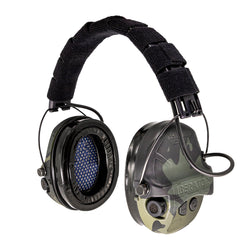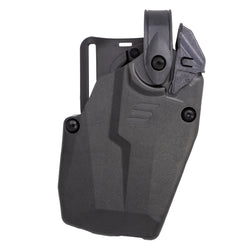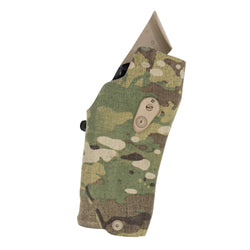Where has time gone? It feels like just yesterday we were camping, hiking, and fishing, and all of a sudden, it’s fall hunting season. I always look forward to antelope season as it offers lots of opportunities to spot and stalk game.
The vast majority of hunters will step into the field with the most accurate long-range rifle they own. We choose to do it a little differently; with a handgun.
Antelope have superpowers
Antelope are North America’s fastest species of land animal. They can also see almost 300 degrees around themselves without turning their head. Their unique ability to see their surroundings and flee from danger makes them difficult to stalk. This is why the vast majority of hunters choose to use long-range capable firearms to make it easier. My wife and I, on the other hand, practice all year for this.
Practice is key
I practice almost daily for my competitive shooting, and my wife goes with me about once a week. Lots of ammunition is fired from 25 to 200 yards with a wheelgun to get ready.
Keeping the practice realistic is key. The vital zone on an antelope is roughly 8 inches in diameter. We use steel plates of vital size or smaller since there is little point in shooting at something larger.

On a stalk, you have no idea what kind of shooting position you will find yourself in. I like to mix it up in practice, shooting from sitting, kneeling, standing, and prone—both supported and unsupported.
Handgun Hunter’s Competition is also a great asset for us in our preparation for hunting season. That little bit of stress caused by a shot timer and small steel targets is as close as you will get to buck fever!

license draw
After practicing, I was hopeful that I would finally draw an antelope tag again; it has been four years. My wife, however, seems to have a horseshoe in her pocket as she draws every year.
In mid-June, I checked my Wyoming draw results, and boy, was I surprised. Not only did I draw one antelope tag, but two! I drew both a buck and a doe tag and could not wait for the season. Of course, my wife drew again as well.
The season begins with a new firearm
Just this past week, the season opened for me. After all these years without a tag, I was ready. I felt well-practiced from both my dedicated hunting practice and my action pistol competitions.

I had something new to take to the field for 2025, a Spohr .44 Magnum. This gun was previously covered here on CADRE Dispatch, so I’ll spare you the fine details. To sum it up, I knew the gun was capable of accuracy. This would be the first hunt a Spohr .44 Magnum has gone on, as this is one of the first production run firearms.
The first hunt
To get in close to antelope, I have to hunt them more like a bow hunter. I look for areas that have a lot of draws, drainages, and hills. For the opening morning, I had just the spot in mind. One hour before sunrise, I hiked about a half mile to a large plateau.
Once on top of the plateau, I took a knee and waited for the sun to come up some. As the light began to build and I could see the glow around the sagebrush and rocks, I began to work around the edges of the plateau.
I crept around for about 15 minutes and began glassing over an edge. I checked every bush and hole for signs of life and came up empty-handed. As I lowered my binoculars, I observed movement out of the corner of my eye.
Just 50 yards away, an antelope buck had stood up when he observed me. I looked at him and saw that his prongs were above his ears (a quick method to decide if an antelope is mature), and they were. Knowing it was still early, I glanced at my watch. I had a full 3 minutes before legal shooting light.
the stare down
The buck and I were in a stare-down. He did not quite know what I was, as my silhouette was concealed by brush. I quietly drew my Spohr .44 from my chest rig and flipped the rubber cover off the Ultradot optic, looking at my watch and him at the same time. As the three minutes passed, the sun shone upon the antelope at the same time.
The lope began to trot to the right. Without hesitation, I brought the gun up to take a shot that I had taken all summer long in action pistol competition: the moving target. I gained a lot of confidence doing so.

The .44 Magnum with a 200 grain Cutting Edge Bullet flies a lot faster than my competition .38 Special ammo. Nonetheless, I have to hold a lead on the target. I placed the 3 MOA dot two dot-sizes in front of the vitals.
I began building pressure on the trigger, and as the shot brok,e the antelope fell instantly. He was quartering slightly towards me, and the round entered in front of his shoulder. The well-placed shot brought the animal down instantly.

This was the first animal ever taken with a Spohr .44 Magnum and likely won’t be the last. There is still a lot of the hunting season to go in Wyoming.

off to deer camp with lots of elk
Immediately following my antelope hunt, I headed out to hunt mule deer. I spent a couple of days working the hills, but with the 85+ degree heat, I didn’t think I would be able to pack out the meat.
In the west, we often have to quarter and pack out the animal as we are miles from a road. We use cloth game bags to protect the meat, but when it is above 60 degrees, you are in the danger zone. Meat can spoil quickly at higher temperatures.
I did, however, see multiple bucks and quite a few elk.

back to chasing antelope
I decided to head out and look for an antelope doe instead. Their smaller size makes pack outs in the heat more doable. I drove two hours to my zone and began hunting that afternoon.
This area was new to me, and I did not scout ahead of time. I was working around a large bowl with little cover to stalk. After a half dozen blown stalks, I went to plan B.
the single shot
I always carry a single shot handgun chambered in a rifle cartridge within my pack. This extends my distance to double what I am capable of with a revolver.
My single shot is an SSK-50 chambered in 309 JDJ with a 1.5-5 Leupold VX3 on top. Yes, it’s a riflescope. I fit a muzzle brake to the barrel to reduce movement from recoil. A rifle scope allows me to shoot in a tighter position, and they also have better glass than the best pistol scopes by far.

The 309 JDJ is somewhat similar to the .308 Winchester. At one time, it was a factory-loaded ammunition option, but now it requires handloading. I load mine with the 150 grain Cutting Edge Bullet that I have had great performance with in the past. I even shot this same gun/ammunition combo at Handgun Hunter’s Competition with great success.
the stalk
So now, with the decision to switch to plan B, my stalking plan had shifted. I found a high spot and glassed for doe antelope. I quickly located a herd I wanted to pursue and began looking for a firing position. I wanted a spot where I could shoot in the prone and have a clear line of sight on the lope.
I worked down a narrow draw and came up upon the rise that placed me level with the antelope. There she was, bedded at 398 yards. I had no cover to conceal myself, and I knew that in short order she would spot me.

I removed my pack, took out my SSK-50, got in the prone, ranged the antelope, and dialed the scope in well under 10 seconds. As soon as the crosshairs settled on the antelope, I began building pressure on the trigger. At the crack of the bullet impact, she fell instantly.

Due to the heat, I quickly took photos and then rapidly quartered the animal so that I could get it back to the cooler in the truck. Antelope meat is one of our favorites in my house, and I don’t want to see it go to waste.

So now I have two antelope back at the house, and we still have one more to go.
Jess’s antelope
My wife, Jess, has been handgun hunting for about three years now. She has taken multiple animals with a single shot handgun and one cow elk with a revolver. She wanted to take her first buck animal with a revolver, so that’s what we set out to do.
Jess is using a Spohr .357 Magnum with Ultradot optic and Cutting Edge Bullets. She has a great deal of confidence in this setup.
The area she was hunting had quite a bit more hunting pressure. Over three days, we stalked multiple herds only to fail at closing the final bit of distance needed. Finally, on the final stalk, the antelope were in a position they would soon regret.
the final stalk
They had worked into a narrow draw that they could not see out of. We crept in slowly, and I could spot a couple of does from the herd well within range. We still could not see the buck; he had to be in the drainage somewhere.
I stopped and held my position while Jess belly crawled to the next rise. As soon as she peaked over the hill there was the buck! Less than 10 yards away and now alert.

He dashed across the small drainage and stopped at 85 yards and turned broadside. He wanted one more chance to identify what had snuck in on him.
Jess was already in the prone and ready, resting the butt of the gun on a Cole Tac Bitty Bag. The second he paused, she sent a 140 grain Cutting Edge Bullet on the way. When the bullet hit the antelope, he instantly fell and expired.
Jess’s first buck with a revolver was on the ground, and our antelope season was complete.

the CHALLENGE
Getting out there and using a handgun when the masses use a rifle just adds to the challenge.
Handgun hunting is something you have to invest in. It takes practice, gear, and patience, as you are not going to excel at this the very first time. All of that work and persistence pays off in dividends of satisfaction when you are successful in the field.











